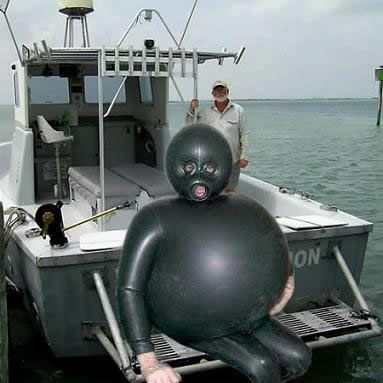 The Bubble Suit !
The Bubble Suit !
Wetsuit diving? Drysuit diving? Nah… that is so 90′s! Let’s try bubble suit diving. Yep. something different, somehting that you will be able to use just to look like an underwater bug. Don’t believe me? Read it here:
During his post-doctoral research at the Massachusetts Institute of Technology, Flynn partnered with his colleague John Bush to study how aquatic insects breathe.
They were fascinated by the critters’ ability to breathe underwater by forming “plastrons,” or bubbles, on their bodies.
When Flynn first embarked upon his research, he toyed with the idea of using his findings to develop a bubble suit that would enable divers to ditch their scuba gear.

He soon realized how implausible such a suit would be, however.
“We had the grand ambition of getting all of these patents and whatnot,” Flynn said.
He explained that humans, with their higher metabolism and larger bodies, would require more oxygen than a bubble suit could provide.
“You would need something the size of a small office to get the appropriate amount of surface area,” Flynn said.
“I never really got my hopes up too high on the scuba suit idea, I guess. It just seemed a little bit too far-fetched.”
In any case, Flynn and Bush’s primary objective was to learn how the bubbles worked, especially with respect to maintaining both stability and efficiency. The findings of their research were published in the Aug. 10 issue of Journal of Fluid Mechanics.
“People have understood for about 100 years or so that these bubbles attached to insects have an important respiratory function,” Flynn said. “We started thinking about the issues of gas exchange and surface chemistry that allows this to happen.”
When aquatic insects dive, bubbles form on their bodies and cling to their long, waxy hairs. Because they breathe through small openings on their bodies called spiracles, the insects can take in the oxygen trapped inside the bubbles.
Some aquatic insects exhaust this oxygen supply, and are forced to resurface and form new bubbles. But other insects, which were the focus of
Flynn’s research, can maintain the bubbles and use them as external “lungs,” with the bubble surfaces facilitating an exchange of oxygen with the surrounding water.
“It allows the insect to replenish oxygen constantly,” Flynn said. “In some cases, this lets the insect stay underwater indefinitely.”
The pygmy backswimmer, for example, can spend four to five months hibernating at the bottom of lakes, said Flynn. He also explains aquatic insects can dive down to 30 metres but in most cases, are found in water one metre deep.
Flynn also studied the behaviour of aquatic insects, and why they tend to flail while underwater. He learned this movement enables the insects to spread bubbles over their bodies.
While a usable “bubble scuba suit” may be far into mankind’s future,
Flynn thinks a reasonable application for his research would be for underwater robots, used by oceanographers and treasure seekers to do the “dirty work” of collecting samples.
The robots are powered by oxygen fuel cells. A bubble mechanism would let them stay underwater longer.
“I know that’s a little bit less glamorous than having humans exploit this technology,” Flynn said. “But you would have the possibility of at least doubling the amount of time these robots spend underwater.”
by
























